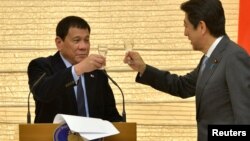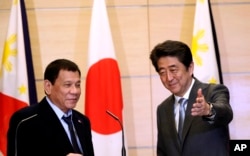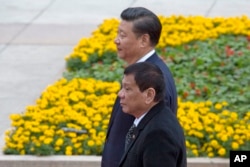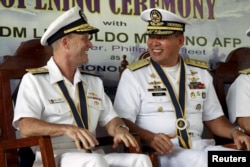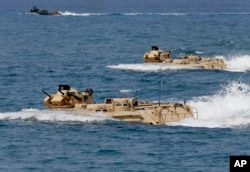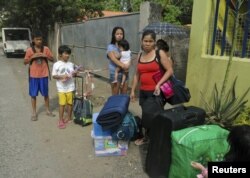Philippine President Rodrigo Duterte’s visit to Japan swings his country a degree back toward the United States despite a strain in relations and it may signal growth of a multilateral foreign policy aimed at maximizing development aid.
The outspoken yet cryptic president’s three-day trip last week cemented a relationship between two democratic Asia Pacific allies. It also generated $19 billion in investment and loan pledges from Tokyo as well as prospects for joint military exercises. Duterte, in office since June 30, made the visit less than a week after meeting Chinese officials, who offered economic help worth about $24 billion.
“It’s a three-way courtship, China, Japan and the U.S., and Duterte knows all of this at this time,” said Eduardo Araral, an associate professor at the National University of Singapore’s public policy school. “At the end of the day he just wants to get more benefits from these relationships.”
China has separate maritime sovereignty disputes with Manila and Tokyo. It accuses the United States of trying to contain its expansion.
Duterte’s two visits followed a string of harshly worded demands that the United States stop helping his country militarily and economically.
The United States is the Southeast Asian archipelago’s former colonizer of nearly five decades and its chief benefactor since World War II, when Japanese troops invaded parts of the country and left between 500,000 and 1 million dead.
US relations
Analysts say the president may be using the Japan trip to craft a foreign policy that includes the United States, just with less dependence than in the past.
Washington is still helping the Philippines resist Muslim separatist rebels and conduct naval patrols that would spot any Chinese vessels in an exclusive economic zone off the archipelago’s west coasts. The United States and the Philippines signed a Mutual Defense Treaty in 1951, obligating each side to support the other if attacked by a third party.
“What [Duterte] says may be very different than actual policy,” said Christian de Guzman, vice president and senior analyst with Moody’s Investors Service in Singapore. "No official diplomatic requests have been made in terms of a change of policy.”
Duterte’s predecessor, Benigno Aquino, filed for arbitration with a world court to stop Chinese vessels from passing within his country’s 370-km (200 nautical-mile) exclusive ocean economic zone in the South China Sea. The maritime dispute fanned widespread public discontent with China.
Polls show that Philippine citizens largely favor U.S. aid compared to help from China, a Communist country with poor relations in recent years because of the maritime dispute.
Generous donor
Japan contributes heavily to the Manila-based Asian Development Bank, which has lent the Philippines an average $745 million per year since 2006 for poverty reduction. The separately run, government-funded Japan International Cooperation Agency (JICA) gave the Philippines $272 million in 2006 alone.
“In the case of Japan, those longstanding commercial and government ties are just being further cemented,” de Guzman said.
In July, the Japanese prime minister offered the Philippines a loan for 10 coast guard patrol ships. Japan has given military and development aid elsewhere in Southeast Asia to counter China’s influence.
Japanese conglomerate Marubeni Corp. will make up $17.2 billion of the Japanese help pledged last week, according to Philippine media reports. That amount would cover highways, electrical power and mass transit projects.
Disaster relief
Aid to date is felt in spots such as the southern Philippine city Cagayan de Oro, where the cooperation agency is helping fund a flood control project, local newspaper columnist Antonio Montalvan said. Flood control became a priority after tropical storm Washi hit the city in 2011 and caused 1,250 deaths.
“Parts of the city were inundated by floodwaters from the river, and it’s JICA, they’re constructing a flood control system now and people see that,” Montalvan said. “So I would think there’s no problem with the Japan aspect of Duterte.”
Duterte may prefer Japan over the United States because, unlike Washington, Tokyo does not criticize the Philippine government’s suspected extrajudicial killings in the crackdown on drugs, analysts say. In turn, the Philippine visitor avoided playing up World War II to his Japanese hosts.
“He got $19 billion worth of aid, and soft loans and potential investments despite the fact that Japan invaded the Philippines and there were a lot of deaths during the World War II,” Araral said. “But Duterte kept his mouth shut because he knows that Japan is a huge donor of the Philippines.”




